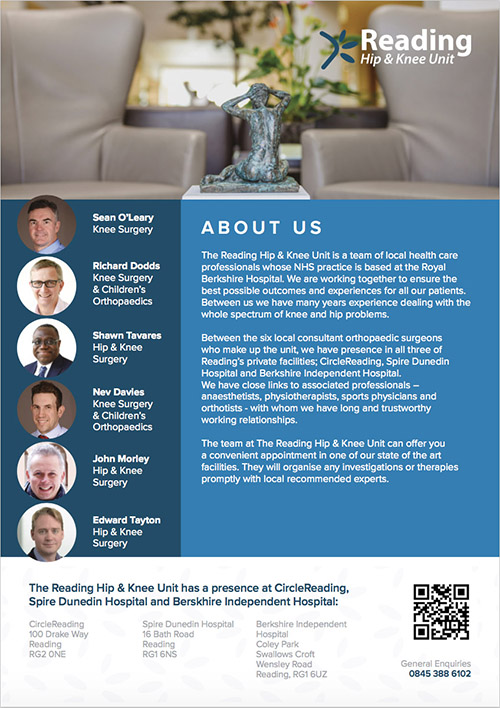Structure of the Knee
The knee joint is one of the largest in the body. It is made up of 3 separate compartments or articulations between the end of the thigh bone (femur), the top of the shin bone (tibia) and the knee cap (patella). These are known medically as the medial (inside) compartment, lateral (outside) compartment and the patellofemoral (kneecap) compartment. The whole joint is surrounded by a bag of soft tissue (capsule), and the inner lining (synovium) of this capsule produces a small amount of lubricating fluid (synovial fluid) to help the joint move smoothly without friction.
There are 2 different types of cartilage in the knee. Firstly the ends of the bones are covered by a layer of smooth joint surface cartilage (articular cartilage). If the joint surface cartilage is damaged either through injury or ‘wear and tear’, then osteoarthritis can develop.
The second type of cartilage in the knee is the meniscal or shock-absorbing cartilage. These are wedge shaped structures that sit between the two main bones that help to distribute the load through the knee during walking and activities. They also contribute to the stability of the knee joint. If these shock absorbing cartilages are damaged, through injury or wear and tear, their load sharing function is compromised, and this can put the underlying articular cartilage at risk of further damage.
The knee gets its main stability by four important ligaments. The anterior cruciate ligament (ACL) and posterior cruciate ligament (PCL) cross in the centre of the knee and run between the two main bones. They act to prevent too much forward and backward motion of the shin bone (tibia) relative to the thigh bone (femur). The ACL also controls rotation of the joint and has important a proprioceptive (joint position) function, sending feedback messages to the brain about where the knee joint is in space. On each side of the knee lie the medial collateral ligament (MCL) on the inside and the lateral collateral ligament (LCL) on the outside. Also important for stability is the back corner of the knee where several thickened areas of capsule make up ‘the posterolateral corner’ (PLC). All four main ligaments as well as the PLC can be damaged in isolation or in combination through injury, which can cause both short term and long term problems.
The key muscles that cross and control the knee comprise of the hamstring group at the back, which bend (flex) the knee, and the quadriceps group at the front which straighten (extend) the knee. The kneecap (patella) sits in the tendon of the quadriceps muscle and moves up and down the groove at the front of the thigh bone as the knee bends and straightens. This ‘extensor mechanism’ is important for walking and going up and down stairs.







